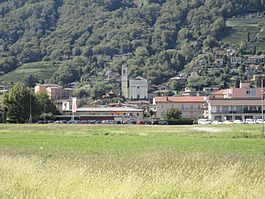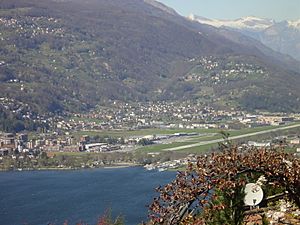Agno facts for kids
Quick facts for kids
Agno
|
||
|---|---|---|

Agno village
|
||
|
||
| Country | Switzerland | |
| Canton | Ticino | |
| District | Lugano | |
| Area | ||
| • Total | 2.5 km2 (1.0 sq mi) | |
| Elevation
(Church)
|
293 m (961 ft) | |
| Population
(Dec 2020 )
|
||
| • Total | 4,376 | |
| • Density | 1,750/km2 (4,530/sq mi) | |
| Postal code |
6982 Agno, 6990 Cassina d'Agno
|
|
| Localities | Cassina d'Agno, Mondonico, Serocca | |
| Surrounded by | Bioggio, Collina d'Oro, Magliaso, Muzzano, Neggio, Vernate | |
Agno is a historic town and a municipality in Switzerland. It is located in the Lugano district, within the Ticino canton. The official language spoken in Agno is Italian.
Agno is known for its beautiful location near Lake Lugano and its important airport. It has a rich history, with evidence of settlements dating back to Roman times. Today, it's a lively place with a mix of old traditions and modern developments.
Contents
History of Agno
Agno was first mentioned in official records in the year 818. Back then, it was called Anium. It was also known by its German name, Eng, but this name is no longer used today.
Early Religious Center
Agno became an important religious center a very long time ago, during the late Roman era. This was when Christianity was spreading in the region. The main church in Agno is dedicated to Saint John the Baptist. This suggests it might have been a place for baptisms.
Old documents from the years 735 and 818 show that there was a religious community in Agno. At first, the church might have followed the Ambrosian Rite, which is a special way of worship. But later, around 1002-1004, it came under the control of the Bishop of Como.
The area around Agno, called the Pieve or Parish of Agno, was very large. It included many villages that are now in Switzerland and some that are in Italy. This large parish lost its political importance after 1803.
Agno as a Community Hub
Agno has always been in a great spot. It's at the northern end of an arm of Lake Lugano and on an important road. Because of this, it might have been a central place even during Roman times. Some ancient Roman items found in Agno are now in the local museum.
Being a central town, Agno became a busy place for trade. It had special rights to hold markets. One of these markets, the Fair of S. Provino, still happens every year in March!
In the Middle Ages, the Bishop of Milan owned fishing rights in Agno. These rights later went to the Bishop of Como and then to private owners. The Swiss government finally removed these fishing rights in 1843.
The main church, San Giovanni Battista, was built on top of older Roman buildings. Inside the church, you can find special items related to San Provino, who was an early Bishop of Como. The oldest part of the village was right at the foot of this church. Over time, the town grew outwards, spreading to the hills and along the roads.
After World War II, Agno grew very quickly. More businesses and industries came to the town. Tourism also became very important, which led to more people moving to Agno, especially after 1960.
Lugano Airport in Agno
A big change for Agno was when the Lugano-Agno airport opened in 1980. This airport allowed regular flights to nearby Lugano. The airport has become more and more important for tourism in Ticino and for the financial businesses in Lugano.
In 1990, about 16,270 flights arrived at the airport, bringing 300,000 passengers. By 1996, the airport was allowed to expand to handle up to 700,000 passengers each year.
Geography of Agno
Agno covers an area of about 3.03 square kilometers (1.17 square miles). A large part of this land, about 50.6%, is used for farming. Forests cover about 23.3% of the area.
About 48.2% of Agno is built up with buildings and roads. A small part, about 2.4%, is covered by rivers or lakes. The rest, about 1.2%, is land that isn't used for farming or building.
The municipality of Agno is in the Lugano district. It's a very important town in the Malcantone valley. Agno includes the main village of Agno and smaller settlements called Cassina, Mondonico, and Serocca.
Transport in Agno
Getting around Agno is easy! The village has its own train station, called Agno station. This station is on the Lugano–Ponte Tresa railway line. Another station, Serocca station, is also in the municipality.
Trains run very often, every 15 minutes during the day on weekdays, and every half hour at other times. Agno station also has a bus service that goes to nearby towns like Aranno and Cademario Casa di Cura.
The main buildings of Lugano Airport are actually located within Agno. The airport is sometimes called Lugano-Agno Airport. There's a shuttle bus that connects the airport to Lugano, and it's also just a 10-minute walk from Agno train station.
Coat of Arms
Agno has its own special symbol, called a coat of arms. It looks like a shield divided into two parts. The top part is red with a white cross. The bottom part is white with a red fish swimming across it.
Images for kids
See also
 In Spanish: Agno para niños
In Spanish: Agno para niños







